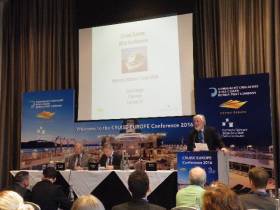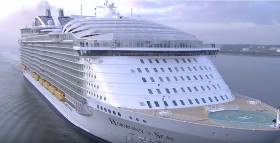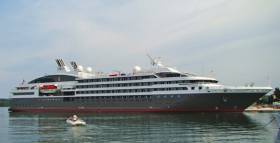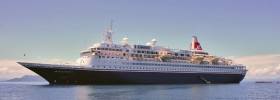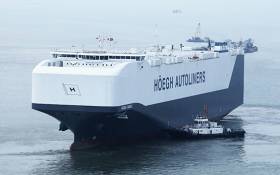Displaying items by tag: Cruise Liners
#FarewellRMSstHelena - One of the world’s most remote inhabited islands, St. Helena, a British Overseas Territory in the South Atlantic Ocean is to lose its unique historic shipping service with South Africa, the only sea connection with the outside world, writes Jehan Ashmore.
The combined passenger and freight vessel RMS St. Helena is to be replaced by a 'cargo-only ship' as the first airport on the island was due to have opened last month. Until this takes place, the RMS St. Helena operates the deep-sea service from Cape Town. It was more than two decades ago when RMS St. Helena made a notable once-off call to Dublin and Cobh (Cork) in 1995.
Both the RMS St. Helena and Cunard Line's Queen Mary 2 belong to a unique club of only a handful of vessels designated with the Royal Mail Ship (RMS) prefix.The vessel of the St. Helena Line is operated by AW Ship Management.
The QM2 and the much smaller 6,797 tonnes RMS St. Helena have called to Dublin Bay, however unlike the liner, the latter vessel was easily accommodated in Dublin Port. It was during that call that I recall the Scottish custom-built vessel for St. Helena Island, berthed alongside Sir John Rogerson’s Quay.
The RMS St. Helena was then on a cruise on behalf of Swan Hellenic, which saw her return to Scottish waters where in Aberdeen she was launched in 1990. Albeit, the cruise was focused on the other side of Scotland along the Western Isles.
‘RMS’ as she is referred to by the 4,500 population of the islanders known as the ‘Saints’, was set to make her final voyage to St. Helena in July. The reason for closing the combined service is primarily due to the opening of the airport, though a ‘freight-only ship’ will be introduced to maintain services to Jamestown, the capital. The island is famous as this is the place of Napoleon Bonaparte's exile and death.
RMS St. Helena, her 59 crew and 139 passengers (just 20 short of full capacity), yesterday morning completed a special voyage returning to the UK, London (Tilbury Cruise Terminal). Originally, RMS St. Helena, served the ocean-going service from UK ports (Cardiff then Portland) but then switched operations running out of Cape Town, South Africa.
Later this week RMS St. Helena is to head upriver along father Thames to the Pool of London, where the ship's career of more than 25 years is to be commemorated. (Afloat.ie will have more on this historic and last visit to the UK capital).
After a series of events held in London, the final voyage of RMS St. Helena that is from the UK is to depart on 14 July with the following ports of call: Tenerife, Canary Islands, Ascension Island, St Helena then back to Ascension. From this British Overseas Territory (likewise of Tristan da Cunha) RMS St. Helena heads back to her island namesake before eventually making a final leg to Cape Town due mid-July. This was meant to be the final ever voyage, however (as further explained below) an extension of South Africa only based voyages are scheduled to continue to late September.
The distance of the this South Atlantic voyage is 1,950km/1,200 miles and takes five-days, compared to the planned introduction of scheduled flights to and from Johannesburg, taking a mere six hours. As previously mentioned the new airport remains to be opened. According to a St. Helena Government statement this is due to the challenges of wind shear identified by the first few flights into the airport that began with the first historic trial flights in April.
Work to address this issue is underway at the new airport and the SHG recognise there are St Helenian’s in Cape Town, the UK and Ascension who are ready to return to St Helena and do not have a confirmed means of doing so. Others will be planning journeys in the coming weeks.
SHG will honour its commitment to maintain access by extending the service of the RMS St. Helena as an interim measure and for a limited period until air services begin. This service as usual will be for passengers and freight. The revised schedule of the RMS St. Helena can be viewed here, noting bookings will be accepted from today, Monday 6 June.
According to the St. Helena Line website, the last of the extended voyages is that of Voyage 246 (9th-27th September). This involves a round trip from Cape Town to St. Helena with a call to Ascension Island. The final port of call is to Cape Town which is scheduled for 27 September, marking the end of this chapter in the island's maritime history.
The travel situation is been kept under review and should an air access solution be found quickly, the SHG would need to reassess plans for RMS St Helena.
#CruiseEuropeConference - In the same week of the Cruise Europe Conference held in Dublin for the first time, another first took place in the port as piles were sunk for the €227m Alexandra Basin Redevelopment (ABR) project enabling much larger cruiseships to berth, writes Jehan Ashmore.
Around 200 delegates of CEC 2016 (which has members within northern and Atlantic Europe) who gathered at the Gibson Hotel overlooking Alexandra Basin, heard Eamon O’Reilly, chief executive of Dublin Port Company, speak of the ABR project. The port is expected to see a doubling of cruiseships visiting the capital over the next decade.
As part of the ABR project much larger cruiseships of up to 330m long will be permitted to turn within the harbour and berth closer to the city-centre at a new terminal. The custom built double berth facility costing €30m will be a first for a port that in 2016 is scheduled to bring 113 cruise ship calls to Dublin this year compared with last year’s total of 93.
Chairman of Cruise Europe Captain Michael McCarthy said “the challenge is to step up to the market to accommodate these ships and investment in such facilities to handle these ships”
Last year the cruise industry carried an estimated 23m passengers generating $125 billion dollars and supporting 930,000 jobs. There were 300 plus cruiseships sailing the world’s oceans with a combined capacity of around 346,000 passengers. This is the 15th successive year of increased global cruise tourism figures and in the period February-April 2016, there was a 16% rise compared to the same period last year. Due to security issues, however in the middle-east some operators have had to cancell cruises in the region.
Keynote speaker of CEC, David Dingle, Chairman of Carnival UK, regarded as the ‘godfather of the industry’ spoke of the unprecedented growth of new and ever larger ships. In total there are 61 cruiseships (185,000 lower berths capacity) currently on the order books between 2016 and 2023. The total gross tonnage is of 7.68m and an estimated investment total of $43.5 billion dollars. That's a 44% capacity growth over 2015 or 6.5% per annum.
The chairman, who paid a visit on board one of the Carnival brands, P&O Cruises Arcadia while at anchorage off Dun Laoghaire Harbour in 2013, also highlighted at the conference that if you were to order a cruiseship now, the newbuild would not be available until 2021. Among the trends for these huge ships is that the average passenger accommodation capacity is 3,000 lower beds and reaching up to a maximum of 5,000 beds.
Dingle added that the trend for mega ships has led to further new on-board cruise 'experience' concepts.
Other delegates from small ship luxury operators spoke of a common theme in that cruise-goers wanted to be have extended port of call stays and overnights. In addition to having an emotional experience of their visits by engaging more so with locals, be it with artists, those in an expert field and in tracing their family roots.
The demand for cruising continues as China looks set to overtake Europe as the world’s second largest regional source market around 2025.
As for the Caribbbean there is pressure for new destinations outside this region. On the other side of the world Australasia has benefitted as larger tonnage has been deployed and new tonnage planned. Going against this trend is notably Brazil, one of the BRICK countries, which has encountered a succession of negative factors from developing this market due to its economic climate, health scares over the Zika virus and political instability.
Among the conference conclusions, critically is that the industry will find it difficult to keep up with the demand to 2025 even with record levels of investment, if present trends are implemented.
Added to the mix is the design of cruiseships in meeting Emissions Control Area (ECA) regulations that came into force in 2015 to reduce sulphur limits in fuel to 0.10%. This will result in vessels operating from the English Channel through the North Sea into the Baltic from 2015, to have increased operating fuel costs of over 50%.
Cruiseships that are LNG powered ships will also need to have associated port related infrastucture in place and that port regulation requires further implentation on a global scale. Also the public perception of such ships requires addressing.
Delegates were also told the very large cruiseships already in service have issues with port terminal infrastructure. As older built terminals posed challenges in not updating gangway designs to sufficiently cater for these high-sided newbuilds.This in turn reflects the time required to embark and disembark passengers.
#DublinBayCalls – A small cruise ship but big on levels of luxury is visiting Dublin Port today and this day next week is scheduled to call to neighbouring Dun Laoghaire Harbour, writes Jehan Ashmore.
After undergoing a multi-million pound refurbishment in Sweden during the Spring, the former Sea Explorer of 4,200 tonnes which had spent a ‘lay-up’ mode in Dun Laoghaire in recent years, has been re-launched under new name MS Hebridean Sky.
The refurbishment undertaken on the 90m cruiseship involved numerous works to the 114-passenger guest capacity ship’s public rooms and five-decks as well as to the accommodation for 72 crew.
In addition during dry-docking numerous technical work was carried out for the vessel's operator, Noble Caledonia which specialises in the small-ship cruising market offering a wide range of luxury vessels to travel to destinations as diverse as the Artic and Papua New Guinea in the south-west Pacific.
Hebridean Sky is one of three flagships and is a sister of MS Island Sky and MS Caledonian Sky. The trio were built in the early 1990’s at the same ship yard in Italy and share attributes that make them among some of the finest small ships in the world. Luxury is enhanced by the use of wood panelling and brass which predominates throughout conveying the atmosphere of a private yacht.
There are 59 spacious suites which have a sitting room area and some have private balconies.
Accommodation is arranged over five decks and all suites have outside views with suites on the Scott and Shackleton decks featuring private balconies. Each suite affords comfort with en-suite bathroom of a marble-topped vanity unit with sink and walk-in shower. Among the suites features are a mini-fridge, flat screen TV with inbuilt DVD/CD player and telephone.
#CruiseEurope2016 – Cruise Europe’s 2016 conference takes place for the first time in the Irish capital this week (31 May- 2 June). The prestigious three-day conference is to attract over 200 delegates from leading cruise destinations to the event co-hosted by Dublin Port Company and Dublin City Council, writes Jehan Ashmore.
The conference coincides with no fewer than seven cruiseliners calling to the capital this week and in a record breaking season with 113 calls scheduled this year. The cruiseships will bring more than 180,000 visitors to experience the city’s sights and attractions. Among those calls, four are turnaround cruises, which will see passengers travel to Dublin Port to begin their cruise.
A notable highlight of the season so far was the first and only Irish port of call for Disney Cruise Line’s impressive 300m long two funnelled Disney Magic which made a maiden voyage to Irish shores last Thursday bringing 3,650 passengers and crew.
Also making an impression in early May was the return call to Dublin Port of MSC Splendida with 4,600 passengers and crew. At 333m the giant ship operated by MSC Cruises is the 11th longest cruiseship in the world and last summer she became the longest vessel ever to visit the capital. Operated by MSC Cruises the ship has also called to Cobh last year and this season.
According to the Chairman of Cruise Europe, Captain Michael McCarthy of Port of Cork Company, the conference represents an opportunity for delegates to nurture long-term relationships, discuss and debate operational issues, regulatory policies, and to explore new ventures and markets. The conference will also be a great opportunity to showcase Ireland to the cruise industry as a destination to all the major cruise lines and service suppliers of the cruise industry worldwide.
Cruise Europe represents 120 ports and associate members on the continent. The goal of the organisation is to have cruise companies, ports and likely destinations working together in a unified manner to ensure safe and enhanced experiences for cruise passengers.
Disney’s 'Magic' Due to Make A Dublin Debut
#DisneyDublin - Disney Magic is to be one of the highlights of Dublin Port's cruise season and as the first Irish port to welcome Disney Cruise Line, a subsidiary of the famous Walt Disney Company, writes Jehan Ashmore.
As previously reported on Afloat.ie, the call next Thursday of the 300m long Disney Magic, only 33 short of the port's record holder MSC Splendida, will have 3,650 people on board visiting the capital. The 84,000 tonnes cruiseship has a 2,700 passenger capacity and they are accommodated in 875 staterooms. In total there are 11 public decks and a crew of 950.
The call by Disney will represent further confidence by the sector in choosing to make Dublin Port a destination in a season scheduled to bring 180,000 visitors from 113 calls. Of those calls four are turnaround cruises, where cruise-goers travel to the capital to begin their cruise.
The cruiseship was built in 1998 by the Italian yard of Fincantieri and the then newbuild was homeported in Port Canaveral, Florida until transferred to Europe almost a decade ago in 2007.
This led Disney Magic to make a repositioning voyage across the Atlantic Ocean and beyond when based out of Barcelona to embark inaugural cruises in the Mediterranean.
Disney Magic has an appearance that clearly echoes to the era of the trans-Atlanctic liners.
The design of having two funnels and painted in red and topped in black pays homage to liners like Normandie, France (see, large containership/longsest cruiseship). This iconic liner latter became converted into a cruiseship as the Norway, that anchored off Dun Laoghaire in the mid-1990’s.
#WorldsLargest - Harmony of the Seas, the world's largest cruiseship and the 25th vessel in the Royal Caribbean fleet has sailed to the UK.
The £783m vessel, which arrived into Southampton yesterday as reported by BBC News, also has footage of the 361m (1,187ft) long ship that can carry 6,780 passengers.
It features 20 restaurants, 23 swimming pools and took more than two-and-a-half years to construct.
The 70m (230ft) high cruise ship had its first trial in March when it was guided out to sea from the port of Saint-Nazaire.
It will leave Southampton for a four-night cruise to Rotterdam on 22 May.
On 26 May it will leave the city again for a three-night cruise to Cherbourg before finally leaving Southampton for its summer base of Barcelona on 29 May.
Afloat adds that due to the sheer size of the vessel built by STX France at St .Nazaire, no port on the the island of Ireland can currently handle such a ship.
European Maritime Day's 2016 Held in Turku, Finland
#EMD2016 – The annual European Maritime Day’s (starting today) is to highlight the importance of the seas and oceans and the challenges facing maritime regions and sectors.
This is the ninth edition of EMD and takes place in Turku, Finland with a conference today and tomorrow, 19 May. There will also be an attractive line up of activities for the general public between 20-22 May.
EMD 2016 is organised in cooperation with the City of Turku and the Finnish government. It will take place in an old locomotive hall called Logomo in Turku.
We are looking forward to an exciting and interactive event focusing on the theme of "Investing in competitive blue growth - smart and sustainable solutions".
More specifically it will focus on identifying and highlighting the practical steps needed to drive blue growth investments, as well as innovation and change in the blue economy.
The EMD conference and exhibition offers a dynamic networking environment for the more than 800 participants registered as well as structured opportunities for mutual exchange and debate through 20 stakeholder workshops, five thematic sessions and two 'Leadership Exchange' panels.
The event will also include matchmaking meetings, a networking village with more than 30 exhibitors, a photo competition, site visits, a classical concert, an art project on marine litter and much more.
Afloat adds that last year’s newbuild cruiseship Mein Schiff 4 (pictured above) made a first visit to Dun Laoghaire Harbour last season. The 2,506 passenger capacity was built at the Turku shipyard for German premium-class operator, TUI Cruises. Next week, fleetmate, Mein Schiff I is to call to the Irish port to launch the season on 26 May.
The almost 100,000 tonnes Mein Schiff 4 had anchored off the East Pier Dun Laoghaire Harbour (see photo), became the last order for STX Finland before the Baltic yard was taken last year by Meyer Turku.
Leadship, Mein Schiff 3 was built in 2013 at the same yard. Meyer Turku will complete TUI Cruises order for further sisters.
Luxury Mega-Yacht Is Galway's First Cruise Call Of 2016
#CruiseLiners - Galway welcomed its first cruise liner call of 2016 last weekend in the shape of the 'luxury mega-yacht' L'Austral, as the Connacht Tribune reports.
Though the vessel only stopped for a day, its 400 passengers and crew made the most of their visit, with sightseeing in the city and a tours to the Burren Kylemore Abbey among their options.
L'Austral's subsequent port of call is Cobh this Sunday (15 May), while Galway's next visitor is as soon as tomorrow (Saturday 14 May) when the Azores calls on the City of the Tribes.
That's one of six remaining cruise calls for Galway in the 2016 season, with Bremen on 11 June, Astor on 10 July, the Pacific Princess and Albatross on 2 and 8 August respectively, and the Prinsendam on 2 September all set to follow.
Four Cruiseships in Three Days! to Visit Killybegs
#4calls3days - Donegal Now writes that four cruiseships in three days are to visit Killybegs making for a busy weekend.
On Saturday, May 14, two ships will be in port together. The MS L'Austral is due to arrive at 7am and an hour later, at 8am, the MS Albatros is scheduled to berth.
On Sunday, at 2.30pm, the MS Boudicca will arrive and, on Monday, 16th, the prestigious MS National Geographic Explorer will tie up at 1.30pm.
Ann Dorrian, who welcomes visitors at the Killybegs Information Centre, said: "This is going to be a very busy few days but we are delighted to see such an interest in Killybegs by the cruise companies."
She added: "Many of the passengers and crews book our Hidden Gems tour up Sliabh Liag and along the spectacular coast road. They are never disappointed."
Saturday will be the big day in Killybegs in more ways than one. As well as the two ships, L'Austral with more than 260 French visitors and the Albatross with 830 Germans, the town will be host to a bus load of American visitors, courtesy of the Cork-based company, EIL Intercultural Learning.
The newspaper has more here.
Dublin Port 'Horizon' Changes With World's Largest PCTC
#WorldsLargest – The World's largest pure car and truck carrier (PCTC) vessel, Höegh Target, with a 14 deck capacity for 8,500 car equivalent units, made another call to Dublin Port today along with a giant cruiseship, writes Jehan Ashmore.
The arrival from Rotterdam of the 76,420 gross tonnes PCTC, is impressive given not just because of the sheer overall size of the leadship of six ‘Horizon’ class Chinese built newbuilds, but also the imposing square shaped upper superstructure at the bow. This compared to a circular conventional car-carrier design, is to maximise additional space to enable a total deck area equal to the size of 10 football fields or 71,400 sqm. Of the 14 decks, five are capable of been 'lifted'.
It is claimed by Norwegian operator, Höegh Autoliners, that the 12 meter width ramp could easily crowd 75 elephants! on the stern ramp which takes 375 tonnes of cargo weight. The final Horizon class that are Post Panamax vessels, is to be delivered this year and they are each estimated to emit 50 per cent less CO2 per car transported than a standard car carrier.
At 200m in length, Höegh Target is some 89m short of the ‘Grand’ class cruiseship, Caribbean Princess which too is docked in port.
As reported today, the 19 deck Caribbean Princess with more than 3,000 passenger capacity called from Cobh, Cork Harbour and is berthed at Ocean Pier. While on the other side of the pier is where Höegh Target docked within Alexandra Basin east.
Both vessels present a temporary high-rise environment on the port estate, where such large vessels are increasing in number to the port. This has led to the Dublin Port Company’s ABR project costing €277m, the largest single capital investment project in the port for 200 years.
The ABR is to permit very large ships with even deeper drafts following major dredging, to dock inside the port.




























